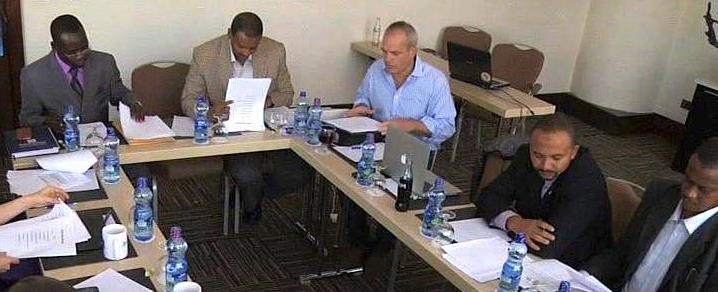March 2013: another Addis negotiating marathon, another document heralded as the ‘breakthrough’ agreement between Sudan and South Sudan. The 68-point implementation matrix (not counting sub-points), signed on March 12 by Idris Mohamed Abdel Gadar for Sudan and Pagan Amum for South Sudan, follows the meeting on March 8 of the defence ministers of both states, who agreed again to withdraw their forces from the previously defined Safe Demilitarized Border Zone (SDBZ).
Or as South Sudan’s negotiating team put it, with a first sentence tongue-twister for bored diplomats and journalists covering the next meeting in Addis: “On March 8, 2013, after months of negotiations, the Republic of South Sudan and the Republic of Sudan’s Joint Political and Security Mechanism (JPSM) came to an agreement on the content of a framework for implementing the commitments made in the bilateral September 2012 security arrangements agreement. This important development should result in the creation of a safe demilitarized buffer zone along the two countries’ shared border. Both sides have already ordered their armed forces to withdraw to their side of the buffer zone.”
Point seven of the March 8 document tells of the delays suffered after the last supposed breakthrough agreement, the cooperation accords of September 2012. It subtly ignores that failure of implementation and just says: “the original D-Day for the implementation plan matrix was 19 December 2012. The matrix has been reviewed and the JPSM have set D-Day at 10 March 2013.”
Three months delay could be forgiven if the intentions of the parties were now honourable. Unfortunately, there is reason to be sceptical of that being the case. Orders by Khartoum and Juba to withdraw their troops from the border are encouraging, but are just as easily reversed. Resuming oil production is welcome, until the next crisis comes. We celebrate the matrix, because even modest progress is better than the alternative. Our faith is in this new bureaucratisation of peace: the idea that if only there are or were enough technical benchmarks, processes, committees, mechanisms and modalities, on paper and on the ground, all that underlying emotional antipathy and mistrust and suspicion could be controlled if not eradicated entirely.
Turning on the oil taps averts economic annihilation for both sides. But having initially shut down production in a bold attempt to show Khartoum that seizures of oil cargoes would not be tolerated, Juba has no guarantee of future good behaviour. That, for example, there will be an end to aerial bombardment by the Sudanese Armed Forces on South Sudan’s territory; that Khartoum will lose interest in the various rebel militias of Jonglei; that Khartoum’s share of oil revenue isn’t used to finance future military action against South Sudan. For its part, Khartoum hasn’t ensured that South Sudan will really expel the SPLM-N officials who frequent Juba, cut off access to South Kordofan from Unity State, or stop exploring alternatives to the Port Sudan pipeline through Kenya and/or Ethiopia.
Plenty of official allegations of bad behaviour have been made by both sides. For the most part these fall to the JPSM to address. In almost every case, the security modalities document says one of the following: “refer to Joint Border Verification and Monitoring Mission (JBVMM) for investigation,” “refer to Ad-hoc Committee for investigation,” or, “on receipt of evidential detail it is recommended JPSM form Committee…to determine veracity of the concern/complaint.” In the unlikely event a thorough investigation is conducted, neither side is likely to be satisfied with the findings: each side believes it is the victim of the other.
With no end in sight to the war in the Nuba Mountains, South Kordofan makes a guest appearance in discussion of border arrangements. More than a year and a half after UNMIS left South Kordofan, and a decade after the successes of the Joint Military Commission (JMC), international monitoring returns to Kordofan: the JBVMM will move from Assosa, Ethiopia, to Kadugli, the capital of Sudan’s presently most troubled state.
As the meeting minutes state: “Kadugli was accepted as a suitable temporary JBVMM HQ before moving to final location in Abyei. There was acceptance that there would be no move of the JBVMM HQ to Abyei until the Temporary Arrangements were implemented and accommodation provided by UN.”
The JBVMM borrows the successful joint monitoring team concept from the JMC. Teams made up of SAF, SPLA, and police and NISS personnel from both sides are joined by international monitors to investigate agreement violations, report on security in the border zone, arbitrate local disputes and report unlawfully held weapons. But whereas in 2002 the JMC monitored violations of a genuine ceasefire in South Kordofan while the war continued in southern Sudan, today’s JBVMM deals with the inverse: international border management between two states legally at peace while civil war continues in the Nuba Mountains, a few towns away.
In the aspirational matrix, where three of the 68 points are marked ‘complete’, and work on most other issues is yet to start, there are the usual bugbears:
“1.4 Obligation: Determination of the final status of Abyei and consideration of formation of the Abyei Referendum Commission (Art 4.2). Timing: Date to be agreed. Responsible: The Presidents.”
“5.4.3. Obligation: Completion of non-binding opinion of the AU Team of Experts (AUTE) on the status of the 5 Disputed Areas. Timing: 5.4.1 [D-Day + 66] + 60 [translation: 126 days from March 10, or July 14]. Responsible: AUTE. Remarks: Parties have commenced cooperation with the Experts in line with draft Terms of Reference for the AUTE. Timeline subject to change by Parties pursuant 5.4.2.”
Indeed, nothing sums it up better: ‘responsible: the Presidents’, and ‘subject to change’. The end of matrix modifications has not yet arrived. But spreadsheets are better than embargoes and air strikes. One hopes the need for urgent breakthroughs does not return too soon.
By Aly Verjee
Re-posted from AfricanArguments.org by permission of the author.
Photo: JPSM secretariat workshop, 16 March 2013 (AUHIP)




